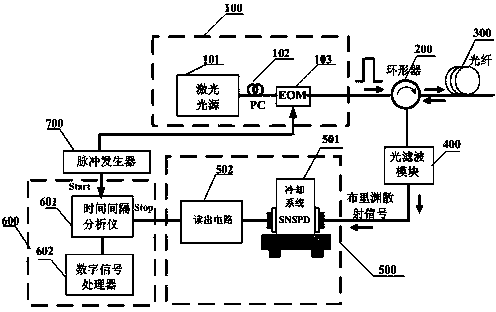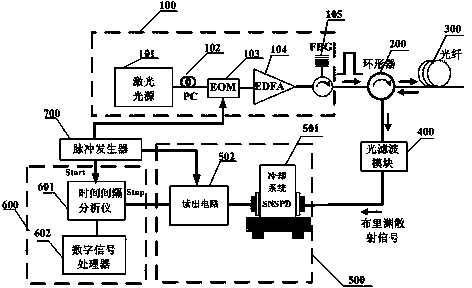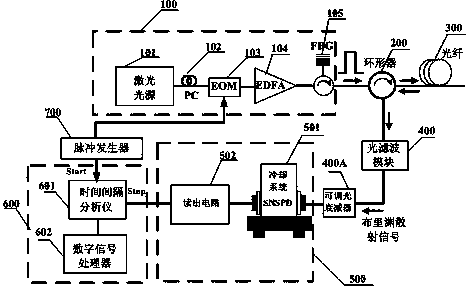Spontaneous Brillouin scattering optical time domain reflectometer based on superconductive nanowire single-proton detector
A technology of single photon detector and optical time domain reflectometer, which is applied in the field of optical fiber sensor network, can solve the problem of weak back Brillouin scattering signal detection ability is limited, no superconducting nanowire single photon detector, resolution It is difficult to improve the rate at the same time, so as to solve the problem of improving the spatial resolution and measurement accuracy at the same time, improving the spatial resolution and measurement accuracy, and improving the dynamic range.
- Summary
- Abstract
- Description
- Claims
- Application Information
AI Technical Summary
Problems solved by technology
Method used
Image
Examples
Embodiment 1
[0029] This embodiment provides a time-domain reflectometer for spontaneous Brillouin scattered light based on a superconducting nanowire single-photon detector. Such as figure 1 As shown, this embodiment includes an optical pulse generating unit 100, the generated optical pulse is coupled into the sensing fiber 300 through the circulator 200, and the backscattered light scattered by the sensing fiber is filtered by the optical filtering unit 400. The back Brillouin scattering signal is obtained after the scattering signal, and the Brillouin scattering signal is detected by the superconducting nanowire single-photon detection unit 500, and finally the output signal of the detector is collected and processed by the data acquisition and processing unit 600, and the pulse generation The device 700 is used for pulse modulation of the optical pulse generation unit and clock control of the data acquisition and processing unit. The optical pulse generation unit 100 includes a narrow...
Embodiment 2
[0036] This embodiment provides a self-Buriouin scattered light time-domain reflectometer based on a superconducting nanowire single-photon detector that can improve the dynamic range, and its structure is as follows figure 2 shown, with figure 1 Compared with the self-Buriouin scattered light time-domain reflectometer based on superconducting nanowire single photon detector, the difference is that: the optical pulse generation unit 100 increases the erbium-doped fiber amplifier (EDFA) 104 and the fiber grating and ring The combined filter 105 is added with the pulse generator 700 to control the bias current of the readout circuit of the detector.
[0037] Erbium-doped fiber amplifier (EDFA) 104 is in order to further amplify the detection light pulse, fiber grating and circulator combination filter 105 is in order to filter out the spontaneous emission noise (ASE noise) of the amplifier, the reflectivity requirement of the fiber grating in the combination filter Up to 99%, ...
Embodiment 3
[0040] This embodiment provides another self-Buriouin scattered light time-domain reflectometer based on a superconducting nanowire single-photon detector that can improve the dynamic range, and its structure is as follows image 3 shown, with figure 1 Compared with the self-Buriouin scattered light time-domain reflectometer based on superconducting nanowire single photon detector, the difference is that: the optical pulse generation unit 100 increases the erbium-doped fiber amplifier (EDFA) 104 and the fiber grating and ring An optical attenuator 400A is added between the optical filtering unit 400 and the superconducting nanowire single photon detection unit 500.
[0041] The difference between this embodiment and the second embodiment is that within a pulse period, the bias current of the detector 500 is constant, and the size of the Brillouin backscattering signal incident on the detector is controlled, and the sensing fiber 300 is divided into several sections , in order...
PUM
 Login to View More
Login to View More Abstract
Description
Claims
Application Information
 Login to View More
Login to View More - R&D
- Intellectual Property
- Life Sciences
- Materials
- Tech Scout
- Unparalleled Data Quality
- Higher Quality Content
- 60% Fewer Hallucinations
Browse by: Latest US Patents, China's latest patents, Technical Efficacy Thesaurus, Application Domain, Technology Topic, Popular Technical Reports.
© 2025 PatSnap. All rights reserved.Legal|Privacy policy|Modern Slavery Act Transparency Statement|Sitemap|About US| Contact US: help@patsnap.com



